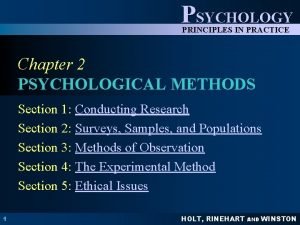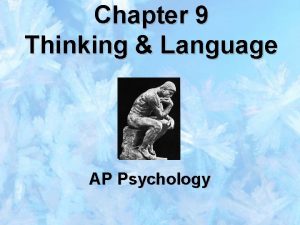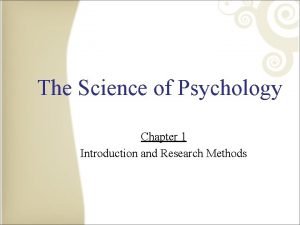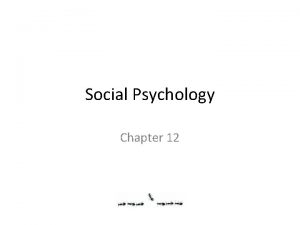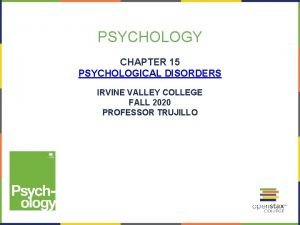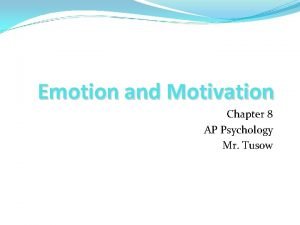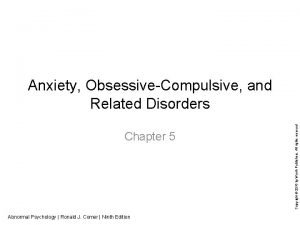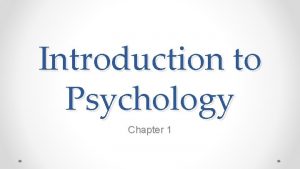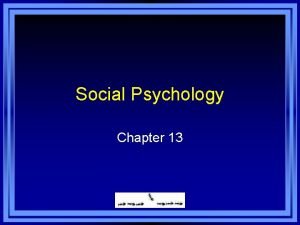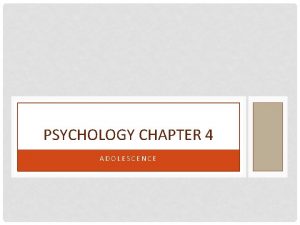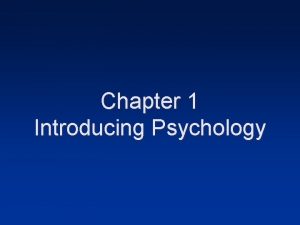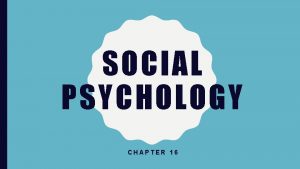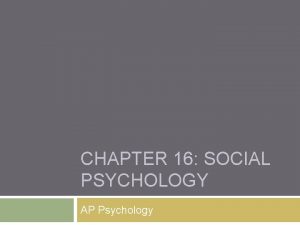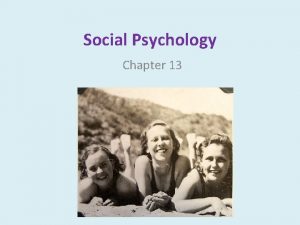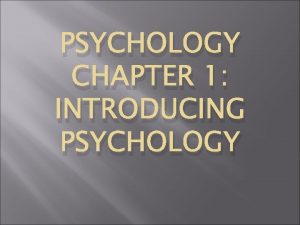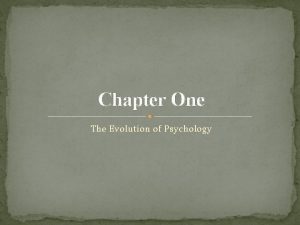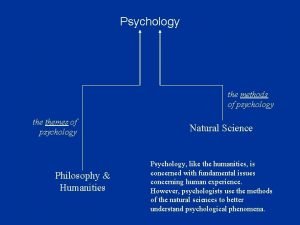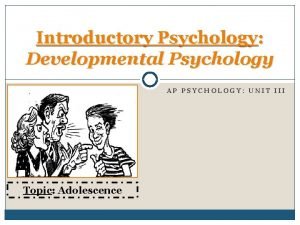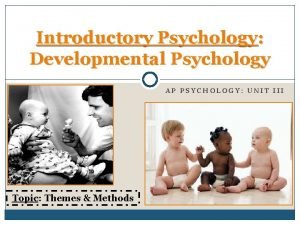PSYCHOLOGY CHAPTER 8 SECTION 5 LANGUAGE LANGUAGE Language



























- Slides: 27

PSYCHOLOGY CHAPTER 8 SECTION 5: LANGUAGE

LANGUAGE • Language is the communication of ideas through symbols that are arranged according to rules of grammar. • Language makes it possible for people to share knowledge.

THE BASIC ELEMENTS OF LANGUAGE • Languages contain three basic elements: phonemes (sounds), morphemes (basic units of meaning), and syntax ( grammar). Combinations of these units create the words, phrases, and sentences that people use to communicate ideas.

PHONEMES • The basic sounds of a language are called phonemes (Languages that do not consist of sounds, such as American Sign Language, do not have phonemes). • The sound of the letter o in dog and no have two different sounds are two different phonemes.

• English contains some phonemes and phoneme distinctions that are not found in other languages. • French has no equivalent for the English th, for example, which is why native French speakers often use a z sound to approximate th in an English word. –“Zee book is on zee table. ”

MORPHEMES • The units of meaning in a language are called morphemes. • Morphemes are made up of phonemes. • Some morphemes, such as car and bike, are words in and of themselves. • Other morphemes are prefixes.

• English uses morphemes such as z and s to make objects plural. • Adding the s morpheme to bike makes it plural. • In English, the past tense of regular verbs is formed by adding the ed morpheme to the end of the present-tense verb. – Walked

• Think does not follow this rule, because it is considered an irregular verb.

SYNTAX • The way in which words are arranged to make phrases and sentences is syntax. • English syntax usually follows the pattern of subject, verb, and object of the verb. • In German the verb often is placed at the end of a sentence.

SEMANTICS • The study of meaning is called semantics. • Semantics involves the relationship between language and the things depicted in the language. • Words that sound alike, such as right and write, can have different meanings, depending on how they are used.

THE STAGES OF LANGUAGE DEVELOPMENT • Children develop language in a sequence of steps. • The sequence is the same for nearly all children. • It begins with crying, cooing, and babbling, then moves into the learning of words, and finally, the learning of grammar.

• Crying, cooing, and babbling are not considered true language because they do not use symbols with specific meanings. • Nevertheless, crying is a highly effective form of verbal expression for newborn infants- it usually gets the attention of newborn of caregivers.

• During their second month, babies begin to coo. • Coos are vowel-like and resemble oohs and ahs. • Cooing seems to express feelings of pleasure. • Different cries and coos can communicate discomfort, hunger, or enjoyment of being rocked, held, or fed.

• At about six months of age, infants begin to babble. • Unlike crying and cooing, babbling has the sounds of speech. • Babies often babble consonant and vowel combinations, as in ba, ga, even the highly valued mama and dada.

• At first, however, combinations with actual meaning, such as mama and dada, are purely coincidental.

• Children from cultures whose languages sound different all babble similar sounds, including sounds they have not heard. • In fact, children babble phonemes found in languages spoken around the world.

WORDS, WORDS • After babbling comes the learning of words- the start of true language. • Most children acquire new words slowly at first. • By 18 months of age, children are saying about two dozen words. • Research indicates that reading to children increases their vocabulary.

• Overextension- when children extend the meanings of words to refer to things for which they do not have words.

DEVELOPMENT AND GRAMMAR • As they approach their second birthday, most children begin to use two-word sentences. • Between the ages of two and three, children’s sentences expand to include missing words.

• Children make errors because they have applied the normal rules to all words, even words for which the rules do not work. • This is called overregulation.

HOW DO WE LEARN LANGUAGE? • Languages pass, with small changes, from generation to generation.

HEREDITY INFLUENCES • Language Acquisition Device (LAD) – People have a natural, or inborn, tendency to acquire language. – LAD makes people most capable of acquiring language between about 18 to 24 months of age.

• One and two year olds seem to learn languages with ease. • In many cases, they learn more than one language.

ECONOMIC INFLUENCES • Learning theorists claim that language learning is similar to other kinds of learned behavior. • Children learn language, at least in part, by observing and imitating other people.

BILINGUALISM • Although most people in the United States speak only one language, the number of people who are bilingual, or speak two languages, is growing. • English is a second language for millions of people in the United States.

• In general, the earlier in life a person learns a second language, the more likely the person is to become fluent in and sound like a native speaker of that language.

• There is a period in life during which language acquisition occurs more easily and effectively than during any other period.
 Group polarization vs groupthink
Group polarization vs groupthink Psychology principles in practice
Psychology principles in practice Chapter 10 meiosis 1 and meiosis 2
Chapter 10 meiosis 1 and meiosis 2 Positive psychology ap psychology definition
Positive psychology ap psychology definition Social psychology ap psychology
Social psychology ap psychology Scope of clinical psychology
Scope of clinical psychology Social psychology is the scientific study of:
Social psychology is the scientific study of: Health psychology definition ap psychology
Health psychology definition ap psychology Example of overconfidence
Example of overconfidence Cross sectional view
Cross sectional view What is a removed section view
What is a removed section view Half section view
Half section view What is the definition of chemical potential energy
What is the definition of chemical potential energy Ap psychology chapter 14
Ap psychology chapter 14 The science of psychology chapter 1
The science of psychology chapter 1 Chapter 12 social psychology
Chapter 12 social psychology What are the 10 personality disorders
What are the 10 personality disorders Motivation ap psychology
Motivation ap psychology Ronald comer abnormal psychology
Ronald comer abnormal psychology Chapter 10 infancy and childhood
Chapter 10 infancy and childhood Short term memory in psychology
Short term memory in psychology Lazarus's appraisal theory
Lazarus's appraisal theory Chapter 10 infancy and childhood review worksheet answers
Chapter 10 infancy and childhood review worksheet answers Introduction to psychology chapter 1
Introduction to psychology chapter 1 Copyright ?
Copyright ? Diathesis psychology
Diathesis psychology Chapter 13 social psychology
Chapter 13 social psychology Chapter 4 adolescence psychology
Chapter 4 adolescence psychology

